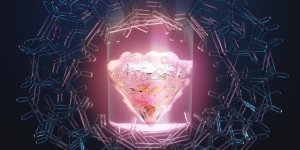| / Documentaries / Science |
Greenland's Jakobshavn Glacier
Science, Oceans, Earth
Jakobshavn Glacier, known in Greenlandic as Sermeq Kujalle, on Greenland's central western side, has been one of the island's largest contributor's to sea level rise, losing mass at an accelerating rate.
In a new study, NASA's Oceans Melting Greenland (OMG) team found that between 2016 and 2017, Jakobshavn Glacier grew slightly and the rate of mass loss slowed down. They traced the causes of this thickening to a temporary cooling of ocean temperatures in the region.
Transcript
Generally speaking, as the climate warms, ice around the planet melts. But how fast it melts and where it melts is complicated by factors like how the climate’s changing and local weather patterns.
Here at NASA, we use satellites, airplanes and research ships to take a closer look at the regional causes of melting and what’s driving them. NASA’s mission Ocean Melting Greenland, or OMG for short, is designed to figure out how much of Greenland’s ice loss is being caused by the oceans.
Sometimes the oceans affected Greenland’s ice in surprising ways. This year, we figured out for the first time in almost 20 years, Greenland’s biggest glacier, Jakobshavn, stopped retreating and got thicker. The big question: Why?
After looking at dozens of potential causes, we figured out that Jakobshavn’s slowdown was caused by cold water that flowed in from offshore. Where Jakboshavn meets the ocean, it sits in water that’s almost 2.400 feet deep — that’s like eight football fields — and this water can affect the glacier very far inland.
Water in Disko Bay, shown here, flows into the canyon, or fjord that holds Jakobshavn, sometimes the water is warm, speeding up the melt of the glacier, and sometimes, it slows it down. In 2016, the water in Disko Bay got cold, reaching temperatures that were lower than at any time since the late 1980s.
Natural cycles cool and then warm the far north Atlantic Ocean about once every 20 years. This cold water from 2016 arrived just as the Atlantic was shifting to its next cold period.
Watch as the deep water temperatures warm up slowly through the years, until 2016, then get cold again.
These waters are brought into Disko Bay by the currents of the North Atlantic, which flow around the southern tip of Greenland, carrying water northward up its west coast. The cold water in Disko Bay caused a dramatic change in Jakobshavn, making it grow taller by 100 feet, or 30 meters, between 2016 and 2017.
What does this mean for Greenland? It means that the oceans play a key role in Greenland’s melt, and we have to watch the water just as closely as the ice if we want to know what the future holds. Here at NASA, we’re hard at work in the field, and the lab, to better understand how the ocean affects Greenland’s melting and how that will continue to change with the climate.
Movie Info
Credit: NASA's Goddard Space Flight Center
Music: Rising Tides by Rainman [PRS]
Lead Producer: Kathryn Mersmann (USRA)
Lead Writer: Carol Rasmussen (NASA/JPL CalTech)
Lead Visualizer: Cindy Starr (GST)
Narrator: Josh Willis (JPL)
Scientists: Josh Willis (JPL), Ala Khazendar (JPL), Ian Fenty (JPL)
Country of origin: United States
Language: English
Released on: March 25, 2019
YOU MAY ALSO LIKE





